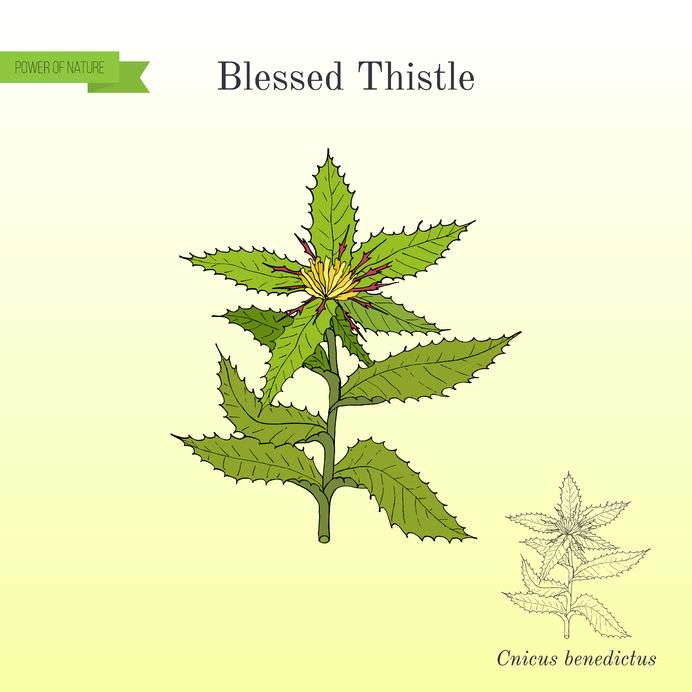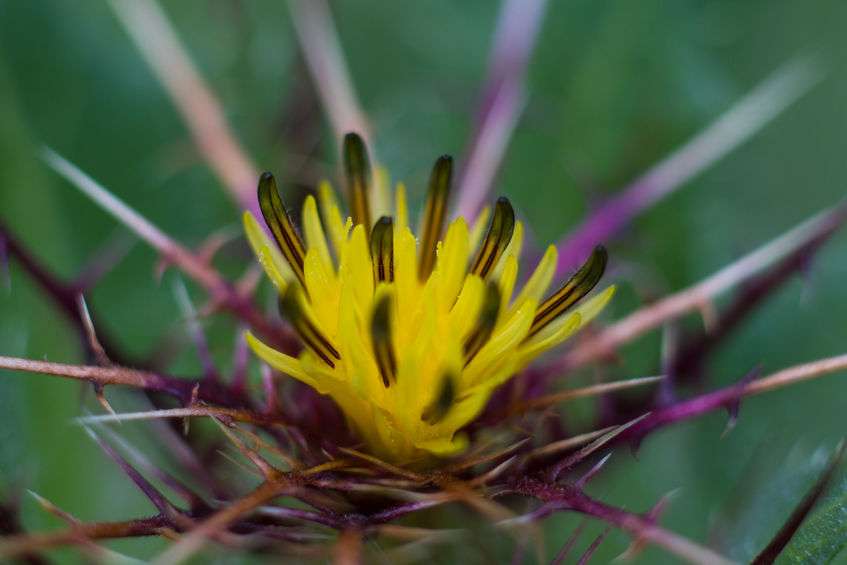
Spiny exterior hides the secret medicinal properties inside. Good use of camouflage if you’re a spiny plant.
Blessed Thistle is native to the Mediterranean and is a member of the Asteraceae (Aster) family, as are Jerusalem Artichoke and Dandelion. It was often grown in the gardens of monks, and the leaves, stems, and blossoms were used to make bitter tonics and liqueurs. Other names for Blessed Thistle include holy thistle, St. Benedict's thistle, and spotted thistle.
There are many different kinds of thistles.
You may think that they look similar but Blessed Thistle can still be identified by its own unique features. It has the characteristic hairy stems and spiny-edged leaves but it also produces bright yellow flowers surrounded by specialized leaves meant to attract pollinators. The plant's leaves can be up to a foot long and the entire plant can reach up to 2 feet. (That’s one way to ensure that your pollinators find you!) Blessed Thistle flowers in June, at which time the leaves and tops are collected, as that is when the plant is at its highest degree of medicinal power.
Why is it called Blessed Thistle? It was grown in monastery gardens throughout Europe, near holy sites and graves to ward off evil. “Blessed” or “holy” refers to the belief that the plant was a gift from a higher power. Its botanical name is Cnicus benedictus.
Once upon a time, Blessed Thistle was used extensively for medicinal purposes. During the medieval period in Europe it was considered a cure for just about every ailment. It is one of the oldest folk remedies for treating the absence of the menstrual cycle, and is often used in commercial herbal preparations formulated for women. The plant is also believed to stimulate bile production in the liver and is used to treat liver disorders of all types. Other modern medicinal uses of Blessed Thistle include regulating the menstrual cycle, improving appetite, lowering fevers, helping lessen bacterial infections, providing anti-inflammatory support, and treating indigestion.
The plant is not considered edible, as it has an extremely bitter taste. Why use a bitter plant to help with digestion? Well, bitters are good for you. They stimulate the secretion of digestive juices in the stomach and support the breakdown of fats, supporting a healthy appetite and assisting in the assimilation of nutrients. The main bitter substance in Blessed Thistle is cnicin.
Blessed Thistle can be made into a tea, although other aromatic herbs should be added to reduce the bitter flavor. Blessed Thistle tea has been used historically by midwives and naturopaths to support healthy breast milk production. That’s because Blessed Thistle is a galactagogue that is used to promote lactation. A galactagogue is any natural or synthetic substance that increases milk production.

Herbal galactagogues have been used for thousands of years. The most commonly used galactagogue herbs are fenugreek, hops, Blessed Thistle, and red raspberry leaves. Blessed Thistle is said to increase milk supply two to three days after consumption.
Blessed Thistle is often used as a treatment for:
• Anorexia
• Arthritis
• Fevers
• Respiratory allergies
• Poor appetite
• Indigestion
• Bronchitis
• Flatulence
• Excess mucus
• Gastrointestinal problems
• Poor liver function
Interesting fact: In Shakespeare's comedy, Much Ado About Nothing, Blessed Thistle, in tincture form, is recommended for a cold.
If you'd like to check out some products that contain Blessed Thistle, please visit these links:
Gynplex by Dynamic Nutritional Associates
ADR Complex by Professional Botanicals
Liver Detox by Professional Botanicals
Liver Detox + Silymarin by Professional Botanicals
_______________________________________________________________________________________________
Note: The content of this article, and additional content on this website, are for informational purposes only and are not intended to be a substitute for professional medical advice, diagnosis, or treatment. Always seek the advice of a physician or other qualified health provider with any questions you may have regarding a medical condition. Never disregard professional medical advice or delay in seeking help because of something you read here on this website.



